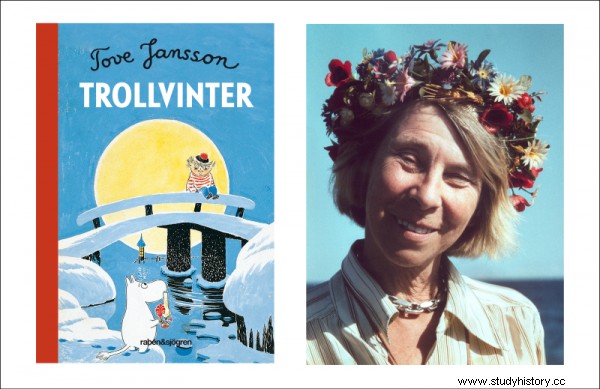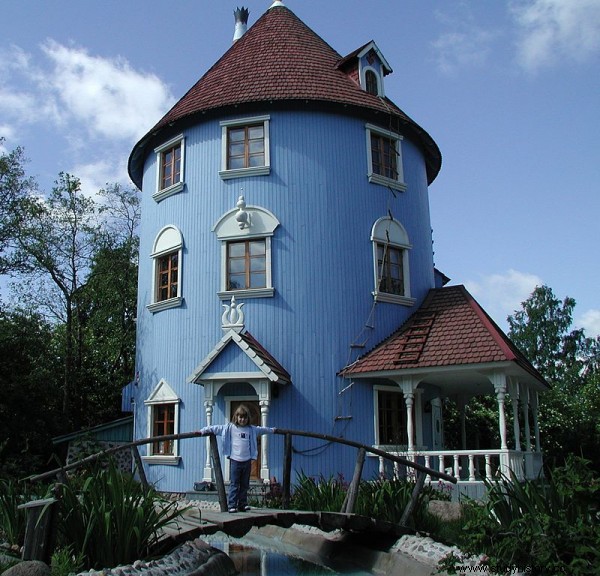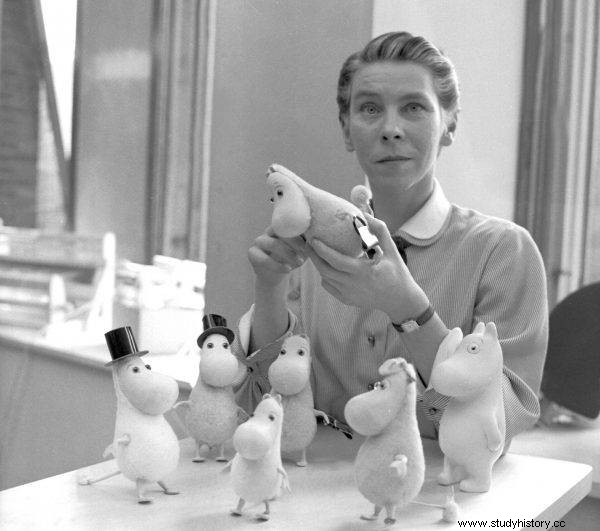Moomins are an icon of pop culture today. Tove Jansson's books about their adventures have been translated into over 30 languages and have sold millions of copies.
It all started with a somewhat eccentric artist turned writer. Of course I am talking about Tove Jansson, also known as - "Moomin mom" . She was born on August 9, 1914 in Helsinki. Her father, Viktor Jansson, was a sculptor, and her mother, Signe, was a designer. Her brothers were also artists:Per Olov Jansson a photographer, Lars Jansson a songwriter and cartoon artist.
Snorkels and other works
Jansson drew for the satirical magazine "Garm", where in the years 1929–1953 there were over 500 caricatures and over 100 pictures for the magazine cover. It was there for the first time in the early 1940s that Moomin-like creatures appeared - Tove called them then "Snorkels" . In the years 1930–1933 she studied painting in Stockholm, then at the Ateneum Art Academy in Helsinki. She also studied in Paris. In the 1930s she traveled several times to Germany, Italy and France.
Initially, her career focused on painting and drawing. Interestingly, despite the fact that for most of her life she was associated with Finland, commonly considered the homeland of the Moomins, actually wrote in Swedish . Her parents came from that country and considered themselves representatives of the Swedish national minority.
In 1933, Tove exhibited her first painting. In the same year, under the pseudonym Vera Haij, she published Sara och Pelle och neckens bläckfiskar - the first book, with its own illustrations, written at the age of 14. She took part in exhibitions, incl. in 1937 at the Artists' Guild in Helsinki. In 1943, her first individual exhibition took place. Another, three years later, was commercially successful. At the turn of the 1930s and 1940s, Jansson was already considered an outstanding Finnish artist of the young generation.
She gained the greatest popularity as a writer and author of books about Moomins. The stories quickly aroused great interest from readers. Published after World War II in Swedish and Finnish, with time translated into over thirty languages and sold in millions of copies worldwide.
How did it all start?
Unconventionally - from a drawing of Moomin, which was made on a wooden wall of the toilet in the family summer house. The picture was inspired by the writer's uncle, who scared her with a troll in her childhood living behind the fireplace. However, if you take a closer look at the toilet prototype, it differs slightly from the actual image. He is much thinner, has more pointed ears and looks like a diaper.

The Moomins did not take their proper shape until the turn of the 1930s and 1940s. It was then that the first manuscript was issued by Tove Jansson.
They took their proper shape only at the turn of the 1930s and 1940s. It was then that the first manuscript was issued by Tove Jansson. "Moomin's Peculiar Journey" was published in 1945 under a changed title:"Little Trolls and a Big Flood." It describes the beginnings of the history of the most famous Finnish family. Moomin and his Mummy go on a journey. They want to find a new home. What about the title flood? It was thanks to her that the Moomin Valley was created, where the famous blue house stood. As we read in the Tove Jansson biography by Boel Westin:
The little trolls and the big flood hadn't come off the printing press well yet as Tove set about her new story. She was burning to write. The Moomin stories wanted to be put on paper and go out into the world. Manuscript for the next part - Komety nad Dolina Muminków - was growing at a dizzying pace in the summer of 1945. The note "I wrote trolls" repeats itself in her calendar and at the end of July Tove states that "Moomin is ready". In the fall, he finishes the work, and in the spring of 1946, joyful information comes from the publishing house:"Tale of Moomins accepted!". She immediately starts making illustrations, and the next episode sprouts in her head.
Him The comet ... landed in bookstores in the fall, she was already in the process of preparing the third book entitled In the Moomin Valley . The urge to "write trolls" turned out to be so strong that she had to admonish herself to "leave the Moomins" - her second solo exhibition was due after the summer holidays - but she just can't resist. (...) Moomin reality is shaped into a picture of life and the author becomes one with her fictional surroundings. (...) "nice evening in the atelier, alone with Moomin" - he concludes in November 1946, creating The valley…
Too-Tiki really existed
Each writer has his own secrets and inspirations. Likewise, Tove Jansson. Starting with the trolls themselves - they have appeared in the Scandinavian tradition for years. Usually, however, they were equated with something completely different . Unlike the Moomins, they were cruelly ugly and malicious . Therefore, the Finnish writer warmed up their mean image a bit.

Located near the Finnish city of Turku, the island of Kailo in Naantali was turned into a Moomin World exactly 30 years ago
In turn, the inspiration for the descriptions of the beautiful Moomin Valley was a tiny, private island of Klovharu located in the Gulf of Finland where Tove and her longtime partner Tuulikki Pietila built a house in 1964. She spent practically every summer there until 1998. The beloved writer served as a prototype for one of the supporting characters living in the Moomin Valley. Too-Tiki is a humanoid heroine, very calm and balanced. In winter, he does not fall asleep. He stays in the Moomin's bathing cabin.
Romance with Włóczykij
Her striped sweater, in turn, refers to the frequent clothes of a good friend of the writer - Atos Wirtanen - the "original" Włóczykij. By the way, his name in the original version of the book was something like "tobacco weirdo." In the author's biography we can read more about the prototype of this nice character :
The meeting of Athos was essential. Those two years with him - confides to Eva on Midsummer 1945 - made everything "richer, warmer and more intense" . Love for him changed me so, she continues, that I could even happily marry him. (...) The marriage did not take place, but during the relationship they talk about it many times.
In the summer of 1945, Tove travels to Atos' home town, Saltvik, north of Mariehamn, to meet his family and explore the Aland Islands with him. Among the local, six of his brothers functioned under the epithet "Saltvik Horror", and Tove was amazed at the difference between them and her man:"huge, wild, laughing boys with a hairy torso, red cheeks and an odd number of fingers, eyes and noses from the fights of youth." What "remarkable chromosomes to produce a philosopher in such a cluster!" Evie comments.
In the last part of the series of books about Moomins - "Moomin Valley in November" - there is also an autobiographical thread. Sam Tove Jansson visits the Moomin house as Homek Toft . However, he only learns that there is no one in it. The author wrote this story after her mother's death in 1970. With the figure of Homek, she probably wanted to mark the void that arose in her life at that time.
The Moomin Valley exists… and it is an island!
Located near the Finnish city of Turku, the island of Kailo in Naantali was turned into Moomin World - an amusement park not only for children, exactly 30 years ago. It is a faithful representation of the Moomin Valley and their entire magical world. We can find there almost all buildings known from books and TV series, and also characters in the summer season. The whole thing was built realistically to the limit. You can sit in Daddy Moomin's chair or look inside Włóczykija's tent.
For those who like more serious attractions, the Moomin Museum has been created in Tempere . His collection includes original illustrations by Tove Jansson for his Moomin books, as well as many other, unpublished drawings. One of the most interesting exhibits is the model of the five-story Moomin house, built by the writer herself.
On paper, screen and theater boards
Moomins do not need to be introduced to anyone today. Known and loved by children - and adults - all over the world, they have become the heroes of numerous serial, film and theater adaptations. The most famous one was created in the early 1990s. It was also broadcast in Poland. It was thanks to her that the Finnish writer's books were read more willingly.

Tove Jansson, apart from a series of nine books, has also created 22 comics about the adventures of the Moomins.
Currently Moomins can be included among the icons of pop culture. They are recognized all over the world, and their homeland - Finland - made them an export product. The image of white, fluffy trolls can be found not only in books or comics, but also on mugs, pencil cases, pens, clothes ... You can exchange endlessly. The rights to the Moomins wanted to buy the Disney company, but the Jansson family , still wielding the entire empire, flatly refused. No wonder, since the legacy of the famous author is valued at seven hundred million euros a year.
Tove Jansson herself apart from a series of nine books, also created 22 comics about the adventures of the Moomins . Later, the series was continued by her brother Lars, publishing another 52 parts. Moomins accompanied the artist until the end of her life. Although she continued her painting career, she was primarily associated with them. With time, she even began to publicly express her regret for being known not for the art she creates, but precisely as a "trollmama". On December 2, 1976 at the Embassy of the People's Republic of Poland in Helsinki, Tove Jansson received the Order of the Smile awarded to her in 1975, at the request of her children, and the ID number 133. She died on June 27, 2001 in Helsinki.
We recommend books related to Moomins on the portal lubimyczyarcie.pl
